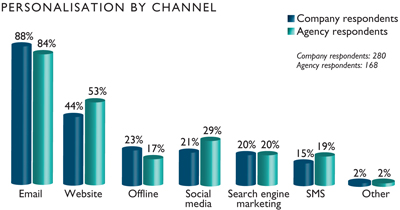This post is by Kathryn Saxon, research group consultant director at MEC.
Personalisation is a priority for marketers in 2015, though we still have some time to go until consumers fully embrace it.
Personalisation was ranked as the most important digital priority for 2015 by marketers, according to the Adobe 'digital roadblock' survey of marketers. This comes as no surprise when taking into consideration the strong commercial case for personalisation. Separate research carried out by Econsultancy, in association with Adobe, revealed that, on average, businesses personalising the customer experience reported a 14% uplift in sales. Of course, levels of personalisation vary by channel, with email leading the way. 88% of companies surveyed by Econsultancy personalised their email channel, while 44% personalised their website and 23% claimed to personalise their offline channels. Lower down still is search engine marketing at 20% and mobile at 15%. Clearly, personalisation is not so omnichannel at the moment, yet 38% of organisations agreed that omnichannel personalisation will become a reality in 2015. With personalisation so high on the agenda for businesses what is the consumer response?

(Click image to enlarge)
We've seen evidence that consumers are becoming progressively more accustomed to personalisation, especially online. 31 per cent of consumers surveyed by Redshift, said they would be more likely to make purchases if they were offered personalised experiences such as product recommendations or tailored content. Interestingly 85 per cent of those surveyed also said brand reputation was not an important factor suggesting there is a gap between what UK consumers are looking for in an online experience and what UK retail brands think they are looking for (The 2014 Consumer and Marketer Personalisation Study, by Redshift Research). There is also a rise in the intolerance of irrelevance – 82% of people surveyed by Nvision agreed with the statement 'I feel negatively towards any organisation that sends me badly targeted marketing communications'. As personalisation grows it can be assumed that expectations will intensify and we anticipate that this number will increase.
Despite some evidence of positive opinion toward personalisation, generally, consumers are conflicted in their views making it all the more harder for marketers. Nvision data shows that two in five adults claim they wouldn't be prepared to share any personal information in order to see relevant ads, whilst some consumers are willing to pay to ensure the total confidentiality of their data. While the rise of anonymous search engines, such as DuckDuckGo, and Google Chrome's introduction of its 'do not track' feature, reveals just how increasingly paranoid (or secretive) consumers are becoming.
A positive view of personalisation will typically derive from the perception of the value exchange. Yet marketers should remember that personalisation is not all about discounts. Nvision found that 60% of those surveyed were interested in some sort of personalised service, not including discounts, in exchange for their personal data. 21% were prepared to share their location for relevant marketing and 34% are interested in a location based service which suggests things to do in your local area. These two things aren't actually very different, but a focus on what you get in return will immediately engage more people.
Where does that leave us then? Marketers will continue to develop personalised approaches driven by big data and solutions to integrate offline and online data whilst consumers remain conflicted and cautious. It's probably therefore all about balance until consumers feel more confident about personalised offers and content. The success of supermarket loyalty schemes demonstrates consumers do become comfortable and familiar with personalisation and embrace it, in fact 74% of those who use loyalty schemes wished they were even more targeted at their needs (source: Nvision). Therefore, when it comes to personalisation, brands should be seen as helping not stalking, think beyond discounts, beyond email, aim for customer experience and overall be more creative.

